菲律宾
盘点菲律宾的十大之最

盘点菲律宾的十大之最菲律宾,这个位于东南亚的美丽岛国,以其壮丽的自然风光和独特的文化吸引着大量的游客。
在这片美丽的土地上,有着许多令人惊叹的事物。
让我们一起来盘点菲律宾的十大之最。
菲律宾是世界上最大的珊瑚岛国。
这个由7,107个岛屿组成的国家,拥有超过20,000平方英里的珊瑚礁,是潜水和浮潜者的天堂。
菲律宾是世界上最大的多岛国。
它以其众多的岛屿而闻名,其中有53个岛屿有居民,而其他的岛屿则是无人居住的天然宝藏。
第三,菲律宾是东南亚地区最多元化的国家之一。
它有着丰富的文化遗产,包括西班牙殖民地时期的建筑和传统的菲律宾舞蹈。
第四,菲律宾有世界上最美丽的海滩之一。
长滩岛的白色沙滩和碧蓝海水吸引着来自世界各地的游客。
这个岛屿也是世界上最长的沙滩之一。
第五,菲律宾有世界上最大的火山口湖。
塔阿尔火山的火山口湖是世界上最大的火山口湖,面积达到110平方公里。
第六,菲律宾是世界上最大的海底火山国家。
它拥有众多的活火山,其中包括塔阿尔火山、马约诺火山和梅卡特拉火山。
第七,菲律宾是亚洲最早的基督教国家之一。
在16世纪,西班牙殖民者将天主教传入菲律宾,使其成为东南亚地区最早接受基督教的国家之一。
第八,菲律宾是世界上最大的花卉出口国之一。
菲律宾的气候和土壤条件使得种植花卉成为一项重要的经济活动。
第九,菲律宾是世界上最大的蜜蜂养殖国家之一。
菲律宾的蜂蜜以其独特的风味和高品质而闻名。
菲律宾是世界上最大的香蕉出口国之一。
菲律宾的香蕉以其丰富的营养和甜美的口感而受到全球消费者的喜爱。
这些仅仅是菲律宾的十大之最,这个国家还有许多其他令人惊叹的事物等待我们去探索。
无论是自然风光还是文化遗产,菲律宾都是一个值得一游的目的地。
让我们一起去菲律宾,亲眼目睹这些壮丽景色和丰富文化吧!。
菲律宾简介

关于菲律宾的一组数据
中文名
外文名
简称 所属洲 首都 主要城市 国庆日 国歌 国家代码 官方语言 货币 时区 政治体制
菲律宾共和国 Republic of the Philippines 菲律宾 亚洲 大马尼拉市 宿务,达沃,奎松等 1898年6月12日 《菲律宾民族进行曲》 PHL 英语 菲律宾比索 UTC+8 总统制共和制
菲律宾简介
Republic of the Philippines
菲律宾地图 菲律宾国旗
菲律宾共和国(Republic of the Philippines)
● 简称菲律宾(Philippines),位于亚洲东南部。北隔巴士海峡与中国台湾省遥遥相对,南和西 南隔苏拉威西海、巴拉巴克海峡与印度尼西亚、马来西亚相望,西濒南海,东临太平洋。共有大 小岛屿7000多个,其中吕宋岛、棉兰老岛、萨马岛等11个主要岛屿占全国总面积的96%。海岸线 长约18533千米,总面积29.97万平方千米。属季风型热带雨林气候,高温多雨,湿度大,台风 多。年均气温27℃,年降水量2000-3000毫米。截至2022年7月,菲律宾全国划分为吕宋、维萨 亚和棉兰老三大部分。全国设有首都地区、科迪勒拉行政区、棉兰老穆斯林自治区等18个地区, 下设81个省和117个市,首都为大马尼拉市。2022年,菲律宾人口约1.1亿
● 铁路
● 菲律宾铁路主要集中于吕宋岛,现有运营铁路线约76.9千米。由于铁路设施远远无法满足交通需 要,菲律宾政府大力发展铁路建设,计划在吕宋岛和棉兰老岛新建南北铁路、棉兰老铁路等,以 改善居民出行交通和满足货运需求。菲律宾交通部预计,2022年之后菲运营铁路线将达到1200 千米。
● 空运
● 菲律宾国内航线遍及40多个城市,主要机场有首都马尼拉的尼诺·阿基诺国际机场、宿务市的麦克 坦国际机场和达沃机场等。菲律宾与30多个国家(地区)签订了国际航运协议,每天或每周都有 多个航班从马尼拉飞往亚洲国家和地区以及美国、欧洲与中东地区的主要城市。
菲律宾

菲律宾的历史发展沿革
• 14世纪后,菲律宾出现了一些由土著部落和马来族移民建 立的割据王国。 • 1521年,麦哲伦率领西班牙远征队到达菲律宾群岛。 1565年,菲律宾成为西班牙殖民地。 • 1898年6月,菲律宾人民推翻西班牙殖民者的统治,宣布 独立,将国民改为菲律宾共和国。同年,美国通过美西战 争签订的《巴黎条约》占领菲律宾。 • 1942年菲律宾被日本占领,第二次世界大战后,美国恢复 其统治。 • 1946年7月,菲律宾摆脱美国的殖民统治,宣布独立。
菲律宾人饮食、喜好及忌讳
• 菲律宾人口味清淡,喜欢香、甜、微辣。喜欢鲜嫩一些的 菜肴,不喜欢吃生姜、动物内脏、腥味大的食物和整条鱼 。 • 菲律宾人非常珍爱白色,红色与茶色被菲律宾人视为不详 之色。忌讳数字13。忌讳用左手递物品、吃东西。
碧瑶
碧瑶市位于菲 律宾首都马尼拉北 部,吕松岛西部, 是一座群山之中的 山城。气候凉爽, 风景秀丽,有“夏 都之称”,为著名 的旅游休养胜地, 面积49平方公里, 人口11万余人。
菲律宾的政治制度
• 菲律宾实行总统共和制。 • 总统是国家元首,国会是最高立法机构,有参、众两院组 成。 • 主要政党有基督教穆斯林民主力量党、民族主义人民联盟 、摩洛民族解放阵线、摩洛伊斯兰解放阵线和菲律宾共产 党等。
菲律宾的经济及货币
• 菲律宾是个农业国,工业以农林产品加工为主。服务业约 占44%。椰子、甘蔗、马尼拉麻和烟草是菲律宾的四大经 济作物。菲律宾的法定货币为比索。
菲律宾,国名 全称菲律宾共和 国,国名是以西 班牙国王菲Байду номын сангаас普 二世的名字命名 的,别称“椰子 之国”。首都马 尼拉市。位于亚 洲东南部的群岛 国家,面积约30 万平方千米。
菲律宾国花--茉莉花
《菲律宾汇总》课件

菲律宾群岛被珊瑚礁环绕,形 成了独特的海洋生态系统。
国家历史
菲律宾历史悠久,最早可追溯至公元 前3000年的石器时代。
1942年,菲律宾被日本占领,二战后 重获独立,并于1950年正式成立菲律 宾共和国。
16世纪,西班牙征服菲律宾群岛,开 始了长达300多年的殖受西班牙和美国影 响,同时又保留了丰富的原住民
旅游须知
语言
菲律宾的官方语言是菲律宾语和 英语,但大多数旅游地区的酒店
、餐馆和商店都使用英语。
货币
菲律宾的官方货币是比索,但美元 在当地也广泛使用。
安全
虽然大部分游客在菲律宾旅行时都 能感到安全,但仍然需要注意个人 财物安全,并避免前往未经开发或 不适合游人的地方。
03
CATALOGUE
菲律宾经济
农业
菲律宾是一个农业国家,农产品 是该国的主要出口商品之一,主 要农作物包括稻米、玉米、椰子
和香蕉等。
制造业
菲律宾的制造业以劳动密集型产 业为主,主要出口商品包括电子
产品和服装等。
经济发展计划
菲律宾政府推出了一系列经济发展计划,旨在促进经济增长和提高国家竞争力。 其中一些计划包括:加强基础设施建设、提高教育水平、促进创新和科技发展等。
教育政策
菲律宾政府重视教育 发展,将教育视为国 家发展的重要基石。
政府还鼓励私人机构 参与教育发展,以提 高教育整体水平。
政府制定了一系列教 育政策,包括提高教 育质量和扩大教育覆 盖面等。
05
CATALOGUE
菲律宾与中国关系
历史关系
16世纪
西班牙殖民统治时期,菲律宾与中国开始接触。
19世纪末
文化遗产。
菲律宾拥有丰富多彩的民间艺术 和手工艺品,如织布、陶器、木
菲律宾十大冷知识
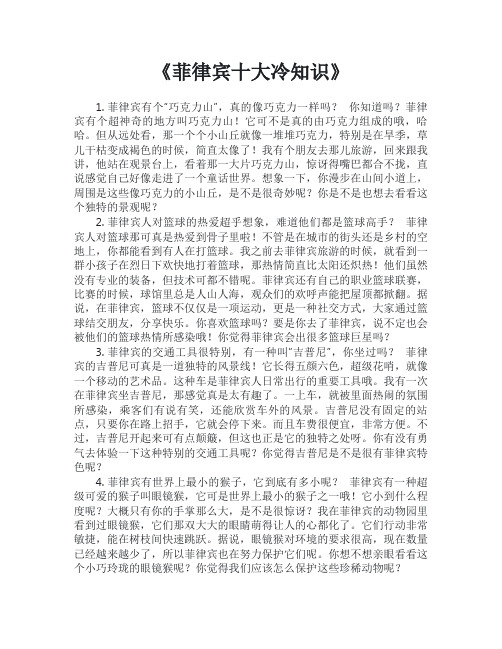
《菲律宾十大冷知识》1.菲律宾有个“巧克力山”,真的像巧克力一样吗?你知道吗?菲律宾有个超神奇的地方叫巧克力山!它可不是真的由巧克力组成的哦,哈哈。
但从远处看,那一个个小山丘就像一堆堆巧克力,特别是在旱季,草儿干枯变成褐色的时候,简直太像了!我有个朋友去那儿旅游,回来跟我讲,他站在观景台上,看着那一大片巧克力山,惊讶得嘴巴都合不拢,直说感觉自己好像走进了一个童话世界。
想象一下,你漫步在山间小道上,周围是这些像巧克力的小山丘,是不是很奇妙呢?你是不是也想去看看这个独特的景观呢?2.菲律宾人对篮球的热爱超乎想象,难道他们都是篮球高手?菲律宾人对篮球那可真是热爱到骨子里啦!不管是在城市的街头还是乡村的空地上,你都能看到有人在打篮球。
我之前去菲律宾旅游的时候,就看到一群小孩子在烈日下欢快地打着篮球,那热情简直比太阳还炽热!他们虽然没有专业的装备,但技术可都不错呢。
菲律宾还有自己的职业篮球联赛,比赛的时候,球馆里总是人山人海,观众们的欢呼声能把屋顶都掀翻。
据说,在菲律宾,篮球不仅仅是一项运动,更是一种社交方式,大家通过篮球结交朋友,分享快乐。
你喜欢篮球吗?要是你去了菲律宾,说不定也会被他们的篮球热情所感染哦!你觉得菲律宾会出很多篮球巨星吗?3.菲律宾的交通工具很特别,有一种叫“吉普尼”,你坐过吗?菲律宾的吉普尼可真是一道独特的风景线!它长得五颜六色,超级花哨,就像一个移动的艺术品。
这种车是菲律宾人日常出行的重要工具哦。
我有一次在菲律宾坐吉普尼,那感觉真是太有趣了。
一上车,就被里面热闹的氛围所感染,乘客们有说有笑,还能欣赏车外的风景。
吉普尼没有固定的站点,只要你在路上招手,它就会停下来。
而且车费很便宜,非常方便。
不过,吉普尼开起来可有点颠簸,但这也正是它的独特之处呀。
你有没有勇气去体验一下这种特别的交通工具呢?你觉得吉普尼是不是很有菲律宾特色呢?4.菲律宾有世界上最小的猴子,它到底有多小呢?菲律宾有一种超级可爱的猴子叫眼镜猴,它可是世界上最小的猴子之一哦!它小到什么程度呢?大概只有你的手掌那么大,是不是很惊讶?我在菲律宾的动物园里看到过眼镜猴,它们那双大大的眼睛萌得让人的心都化了。
菲律宾人文风俗语言

菲律宾人文风俗语言菲律宾,这个美丽的岛国,拥有丰富多样的人文风俗和语言。
作为一个多民族国家,菲律宾有着多种不同的语言和方言,反映了不同地区的文化和历史。
让我们一起来了解一下菲律宾的人文风俗和语言。
一、菲律宾人文风俗菲律宾人热爱音乐和舞蹈,音乐和舞蹈活动是他们社交和文化交流的重要方式。
例如,他们有着独特的传统舞蹈,如塔舞(Tinikling)和卡里略舞(Karioka)。
这些舞蹈通过精巧的足部技巧和优美的舞姿展示了菲律宾人的热情和灵活性。
此外,菲律宾人也热衷于庆祝节日和特殊场合。
像圣诞节(Pasko)和复活节(Mahal na Araw)这样的节日是菲律宾人团聚和表达心意的重要时刻。
在这些特殊的日子里,菲律宾人会举行盛大的庆祝活动,表演音乐、舞蹈和烟花。
此外,菲律宾人还有独特的家庭价值观念。
他们强调家庭的重要性,珍视亲情和友情。
菲律宾人通常和父母、兄弟姐妹住在一起,并以多代同堂的模式生活。
这种家庭结构使得他们的亲密关系更加紧密,互相照顾和支持。
二、菲律宾语和方言菲律宾语(Filipino)是菲律宾的官方语言,属于马来-波利尼西亚语族。
它是以塔加洛语(Tagalog)为基础,混合了西班牙语、英语和马来语等其他语言的词汇和语法特点。
除了官方语言外,菲律宾还有许多方言,其中最常用的包括比科尔语(Bicolano)、卡皮桑语(Kapampangan)、伊洛卡诺语(Ilocano)和塔威塔威语(Cebuano)等。
这些方言在不同的地区间流行,并反映出菲律宾的多样性。
菲律宾人使用语言表达他们的思想和感情,他们善于表达和交流。
在与他人交谈时,菲律宾人通常会用行话、俚语和谚语来增加亲和力和幽默感。
三、语言对菲律宾社会的影响语言在菲律宾社会中扮演着重要的角色,它不仅是人们沟通的工具,也是文化传承的载体。
通过语言,菲律宾人传递着他们的价值观和信仰,表达着对家庭和友情的热爱。
此外,语言还反映了菲律宾社会的多元化和包容性。
菲律宾地理位置分析
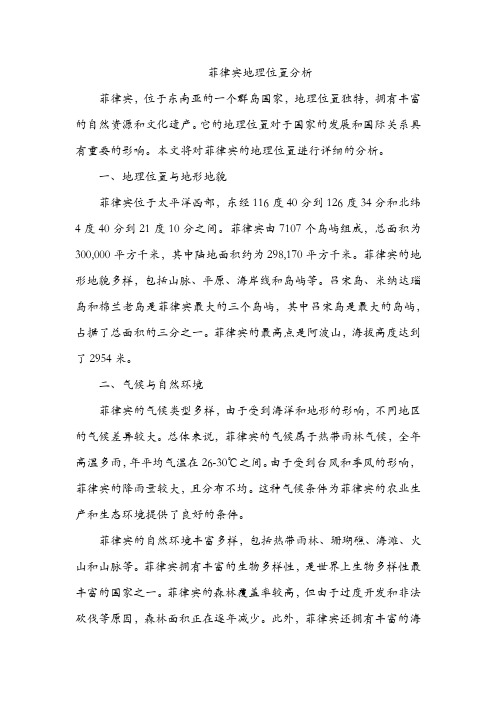
菲律宾地理位置分析菲律宾,位于东南亚的一个群岛国家,地理位置独特,拥有丰富的自然资源和文化遗产。
它的地理位置对于国家的发展和国际关系具有重要的影响。
本文将对菲律宾的地理位置进行详细的分析。
一、地理位置与地形地貌菲律宾位于太平洋西部,东经116度40分到126度34分和北纬4度40分到21度10分之间。
菲律宾由7107个岛屿组成,总面积为300,000平方千米,其中陆地面积约为298,170平方千米。
菲律宾的地形地貌多样,包括山脉、平原、海岸线和岛屿等。
吕宋岛、米纳达瑙岛和棉兰老岛是菲律宾最大的三个岛屿,其中吕宋岛是最大的岛屿,占据了总面积的三分之一。
菲律宾的最高点是阿波山,海拔高度达到了2954米。
二、气候与自然环境菲律宾的气候类型多样,由于受到海洋和地形的影响,不同地区的气候差异较大。
总体来说,菲律宾的气候属于热带雨林气候,全年高温多雨,年平均气温在26-30℃之间。
由于受到台风和季风的影响,菲律宾的降雨量较大,且分布不均。
这种气候条件为菲律宾的农业生产和生态环境提供了良好的条件。
菲律宾的自然环境丰富多样,包括热带雨林、珊瑚礁、海滩、火山和山脉等。
菲律宾拥有丰富的生物多样性,是世界上生物多样性最丰富的国家之一。
菲律宾的森林覆盖率较高,但由于过度开发和非法砍伐等原因,森林面积正在逐年减少。
此外,菲律宾还拥有丰富的海洋资源,包括各种鱼类、贝类和海藻等。
三、自然资源菲律宾的自然资源丰富多样,包括矿产、能源、农业和渔业等资源。
菲律宾的矿产资源主要有金、银、铜、铁、铬和镍等。
其中,金和铜的储量较为丰富。
在能源方面,菲律宾的煤炭和石油资源相对较少,而天然气和水力资源的开发潜力较大。
在农业方面,菲律宾的主要农作物包括水稻、玉米、椰子、甘蔗和烟草等。
渔业也是菲律宾重要的经济来源之一,拥有丰富的海洋渔业资源。
四、地缘政治与经济发展菲律宾位于东南亚地区的中心地带,地缘政治地位重要。
它与中国、日本、韩国等亚洲大国以及美国等西方国家保持着密切的经贸和政治联系。
菲律宾国家怎样

菲律宾国家怎样
菲律宾共和国,简称菲律宾,位于东南亚的一个群岛国家,位于西太平洋,是东南亚一个多民族群岛国家,面积29.97万平方公里,人口1.049亿。
菲律宾人的祖先是亚洲大陆的移民,14世纪前后建立了苏禄国。
1565年沦为西班牙殖民地。
1898年6月12日宣布独立。
同年美西战争后,成为美国殖民地。
1942年到1945年被日本侵占。
二战后重新沦为美国殖民地。
1946年7月4日,菲律宾获得独立。
菲律宾主要分吕宋、米沙鄢和棉兰老岛三大岛群,共有大小岛屿7000多个,种族与文化为数众多,融合了许多东西方的风俗习惯。
菲律宾气候
菲律宾属季风型热带雨林气候,高温、多雨、湿度大、台风多。
年平均气温约27℃,年平均降水量大部分地区在2000-3000毫米之间。
菲律宾没有四季,只有旱季(11-次年4月)和雨季(5-10月)之分。
菲律宾文化
受西班牙殖民影响,菲律宾人几乎全民信教,以天主教和基督教为主,极少数穆斯林。
因为信仰原因,在菲律宾堕胎是违法的。
菲律宾人以多子多孙为福,一般祖孙三代一家
子可以有上百人,家庭之间相互帮助其弟妹或子侄完成学业。
菲律宾共和国名词解释
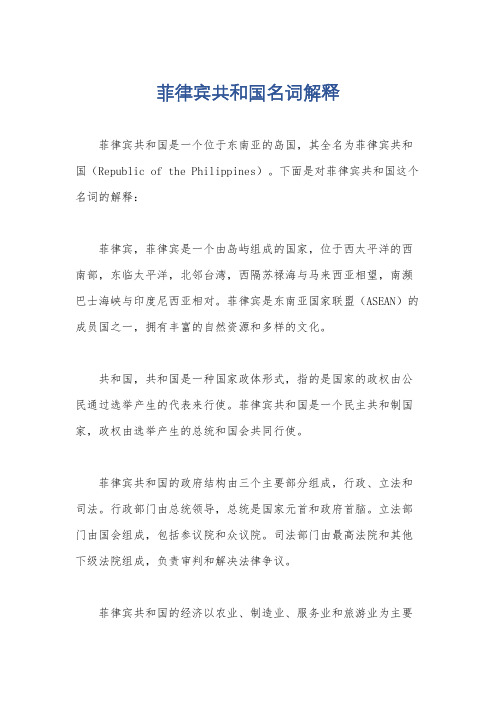
菲律宾共和国名词解释
菲律宾共和国是一个位于东南亚的岛国,其全名为菲律宾共和国(Republic of the Philippines)。
下面是对菲律宾共和国这个名词的解释:
菲律宾,菲律宾是一个由岛屿组成的国家,位于西太平洋的西南部,东临太平洋,北邻台湾,西隔苏禄海与马来西亚相望,南濒巴士海峡与印度尼西亚相对。
菲律宾是东南亚国家联盟(ASEAN)的成员国之一,拥有丰富的自然资源和多样的文化。
共和国,共和国是一种国家政体形式,指的是国家的政权由公民通过选举产生的代表来行使。
菲律宾共和国是一个民主共和制国家,政权由选举产生的总统和国会共同行使。
菲律宾共和国的政府结构由三个主要部分组成,行政、立法和司法。
行政部门由总统领导,总统是国家元首和政府首脑。
立法部门由国会组成,包括参议院和众议院。
司法部门由最高法院和其他下级法院组成,负责审判和解决法律争议。
菲律宾共和国的经济以农业、制造业、服务业和旅游业为主要
支柱。
该国拥有丰富的自然资源,如矿产、森林和渔业资源,同时
也是全球重要的电子产品和海外劳工出口国。
菲律宾共和国的文化多元且丰富,受到马来、西班牙、美国和
中国等多个文化的影响。
该国有多种语言和方言,其中菲律宾语是
官方语言之一。
总结起来,菲律宾共和国是一个东南亚的岛国,拥有丰富的自
然资源和多元文化,采用民主共和制的政体形式。
它的政府由行政、立法和司法三个部门组成,经济以农业、制造业、服务业和旅游业
为支柱。
菲律宾(菲律宾共和国)(一)2024

菲律宾(菲律宾共和国)(一)引言概述:菲律宾共和国(Philippines),简称菲律宾,是位于东南亚的一个岛国,由7,641个岛屿组成。
它拥有丰富的自然资源和多样的文化遗产,是一个值得探索和了解的国家。
本文将从经济、地理、政治、文化和旅游五个方面进行解读。
一、经济1. 菲律宾的经济体系是新兴市场经济,以服务业为主导,尤其是外包服务行业的兴起。
2. 农业是菲律宾经济的重要支柱,主要农产品包括稻米、椰子、糖、香蕉等,农业产值占国内生产总值的一部分。
3. 菲律宾的旅游业发展迅速,吸引了大量的国内外游客,为经济带来了可观的经济收入。
4. 菲律宾面临一些经济挑战,包括扶贫问题、不平等分配和基础设施建设的不足等。
二、地理1. 菲律宾位于东南亚,东邻太平洋,西隔南海与越南相望,南濒苏拉威西海。
2. 菲律宾由7,641个岛屿组成,其中有一些岛屿是活火山,造就了绚丽而多样的地貌景观。
3. 菲律宾的气候属热带气候,常年高温多雨,有利于农业和旅游业的发展。
4. 菲律宾濒临环太平洋地震带,地震和台风是该国常见的自然灾害。
三、政治1. 菲律宾是一个民主共和国,政治体制为总统制。
2. 菲律宾的国家元首是总统,由公民选举产生,任期为六年。
3. 菲律宾国会由参议院和众议院组成,负责议会法制和政策制定。
4. 菲律宾政治局势复杂,面临一些挑战,如贫困、腐败和分离主义问题等。
四、文化1. 菲律宾文化受到西班牙和美国的影响,具有独特的混合特点。
2. 宗教是菲律宾社会的重要组成部分,绝大多数人信奉天主教。
3. 菲律宾有丰富多样的民俗文化和传统节日,如圣诞节、复活节和独立日等。
4. 艺术、音乐和舞蹈在菲律宾文化中占有重要地位。
五、旅游1. 菲律宾拥有壮观的自然景观,包括美丽的海滩、壮丽的森林和火山景观等,吸引了众多游客。
2. 菲律宾有世界闻名的潜水胜地,拥有丰富的海洋生物和珊瑚礁,吸引了众多潜水爱好者。
3. 菲律宾还有丰富多样的文化遗产,包括古老的教堂、博物馆和历史遗迹等。
菲律宾属于哪个国家
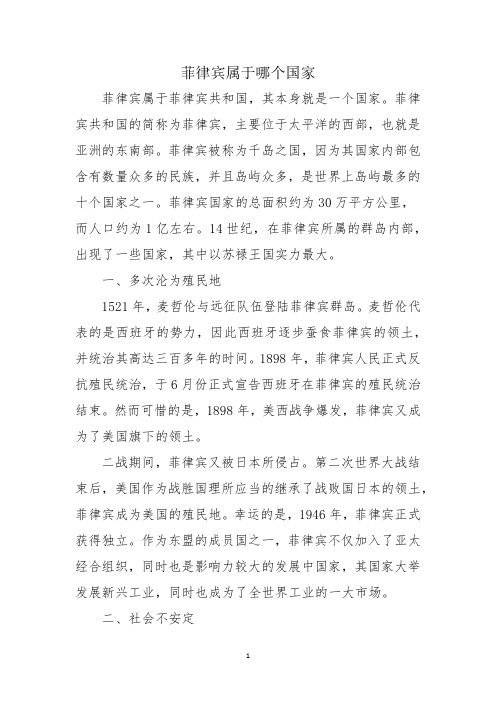
菲律宾属于哪个国家菲律宾属于菲律宾共和国,其本身就是一个国家。
菲律宾共和国的简称为菲律宾,主要位于太平洋的西部,也就是亚洲的东南部。
菲律宾被称为千岛之国,因为其国家内部包含有数量众多的民族,并且岛屿众多,是世界上岛屿最多的十个国家之一。
菲律宾国家的总面积约为30万平方公里,而人口约为1亿左右。
14世纪,在菲律宾所属的群岛内部,出现了一些国家,其中以苏禄王国实力最大。
一、多次沦为殖民地1521年,麦哲伦与远征队伍登陆菲律宾群岛。
麦哲伦代表的是西班牙的势力,因此西班牙逐步蚕食菲律宾的领土,并统治其高达三百多年的时间。
1898年,菲律宾人民正式反抗殖民统治,于6月份正式宣告西班牙在菲律宾的殖民统治结束。
然而可惜的是,1898年,美西战争爆发,菲律宾又成为了美国旗下的领土。
二战期间,菲律宾又被日本所侵占。
第二次世界大战结束后,美国作为战胜国理所应当的继承了战败国日本的领土,菲律宾成为美国的殖民地。
幸运的是,1946年,菲律宾正式获得独立。
作为东盟的成员国之一,菲律宾不仅加入了亚太经合组织,同时也是影响力较大的发展中国家,其国家大举发展新兴工业,同时也成为了全世界工业的一大市场。
二、社会不安定但可惜的是,菲律宾的最高经济水平有所进步,但内部贫富差距非常大。
即便经济有所发展,但可惜的是菲律宾的政治一年不如一年。
尤其是政府历年来有许多贪污腐败的丑闻,这使得其政局动荡频繁,各种起义活动频发,社会愈发不安定。
国家连统一都没有办法保证,因此,也难以有更远发展。
2018年,菲律宾退出国际刑事法院。
在经济全球化的潮流当中,菲律宾不但没有积极加入和融合全球化的趋势,反而往全球化发展潮流的反面发展。
由此可见,其将来的发展必定阻碍重重。
2020年,新冠病毒在全球范围内传播。
由于发展水平受限,科技水平受限,菲律宾难以应付病毒的肆虐,早早的便进入了灾难状态,而在六个月的灾难状态中,菲律宾没能做到对病毒积极反抗,自主治疗,情况并不好。
菲律宾旅行攻略
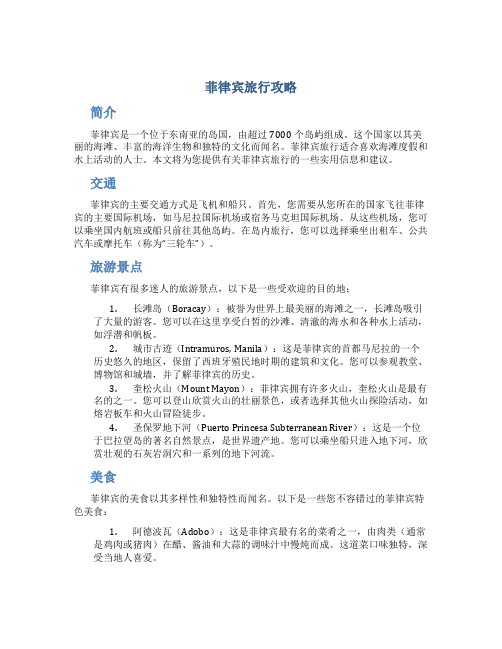
菲律宾旅行攻略简介菲律宾是一个位于东南亚的岛国,由超过7000个岛屿组成。
这个国家以其美丽的海滩、丰富的海洋生物和独特的文化而闻名。
菲律宾旅行适合喜欢海滩度假和水上活动的人士。
本文将为您提供有关菲律宾旅行的一些实用信息和建议。
交通菲律宾的主要交通方式是飞机和船只。
首先,您需要从您所在的国家飞往菲律宾的主要国际机场,如马尼拉国际机场或宿务马克坦国际机场。
从这些机场,您可以乘坐国内航班或船只前往其他岛屿。
在岛内旅行,您可以选择乘坐出租车、公共汽车或摩托车(称为“三轮车”)。
旅游景点菲律宾有很多迷人的旅游景点,以下是一些受欢迎的目的地:1.长滩岛(Boracay):被誉为世界上最美丽的海滩之一,长滩岛吸引了大量的游客。
您可以在这里享受白皙的沙滩、清澈的海水和各种水上活动,如浮潜和帆板。
2.城市古迹(Intramuros, Manila):这是菲律宾的首都马尼拉的一个历史悠久的地区,保留了西班牙殖民地时期的建筑和文化。
您可以参观教堂、博物馆和城墙,并了解菲律宾的历史。
3.奎松火山(Mount Mayon):菲律宾拥有许多火山,奎松火山是最有名的之一。
您可以登山欣赏火山的壮丽景色,或者选择其他火山探险活动,如熔岩板车和火山冒险徒步。
4.圣保罗地下河(Puerto Princesa Subterranean River):这是一个位于巴拉望岛的著名自然景点,是世界遗产地。
您可以乘坐船只进入地下河,欣赏壮观的石灰岩洞穴和一系列的地下河流。
美食菲律宾的美食以其多样性和独特性而闻名。
以下是一些您不容错过的菲律宾特色美食:1.阿德波瓦(Adobo):这是菲律宾最有名的菜肴之一,由肉类(通常是鸡肉或猪肉)在醋、酱油和大蒜的调味汁中慢炖而成。
这道菜口味独特,深受当地人喜爱。
2.烤猪(Lechon):这是菲律宾的传统节庆菜肴,是一整只猪经过特殊处理和烤制而成。
烤猪皮脆,肉质鲜嫩多汁,是一道适合与家人和朋友共享的美食。
3.酸辣汤(Sinigang):这是一道菲律宾的传统酸辣汤,使用酸性水果(如酸橙或番茄)来调味。
菲律宾共和国

马尼拉大教堂
马尼拉大教堂是马尼拉天 主教大主教管区的主要建 筑,最初的教堂建于1581 年,马尼拉大教堂是菲律 宾最大和最古老的天主教 堂,1958年由梵蒂冈出资 修复,是广大的教徒心中 的圣地,信奉天主教的菲律 宾人每个周日都在这里做 礼拜。
马尼拉的交通
马尼拉的交通非常方便,市民出门不论远近均习 惯乘车,市内的交通工具主要有轻轨、公共汽车 和“吉普尼”[Jeepney]车等。“吉普尼”由于价 格便宜,线路遍布城市的每个角落,是最为常用的交 通工具.它是一种带车篷的厢式吉普车,其车厢内 有相对而坐的两排座位,乘客可随时打招呼上下。 吉普尼是最初是用作二战时运送美国士兵的交通 工具,是拼用旧车部件改装并经过交通局检验的组 装车.
碧瑶市
碧瑶市位于菲律宾首都马
尼拉北部,吕松岛西部, 是一座群山之中的山城。 气候凉爽,风景秀丽,有 “夏都之称”,为著名的 旅游休养胜地,碧瑶原是 菲律宾北方山区部落伊戈 洛特等少数民族聚居的地 方,建市至今才80多年。 和马尼拉、宿务一起被认 为是菲律宾华人的主要聚 居城市。碧瑶是菲律宾的 “夏都”又称“花都”, 深受各地游客的青睐和神 往。
地形、地貌、气候和降水
• 群岛南北长1855公里,东西宽1098公里,由7107个岛 屿组成,素有“千岛之国”之称,有名的有2800个, 有人居住的约1000个,面积在1平方公里以上的有466 个。 • 从自然地理划分,菲律宾可以划分为5个部分:吕宋岛、 米沙鄢群岛、棉兰老岛、巴拉望岛和苏禄群岛。群岛 从南至北呈花状散开,构成了菲律宾通向加里曼丹的 两条岛链。 • 菲律宾群岛多山,其走势为南北纵列,各岛有山,山 地占全国面积的3/4,而且火山众多,地震频繁。全岛 最高峰是普洛山,海拔为2928米;东南部的马荣火山 2421米,被称为世界上“最完美的火山锥”。 • 菲律宾两侧则是深海,萨马岛和棉兰老岛东面是菲律 宾海沟,最深处达10497米,为世界最深海区之一。
菲律宾
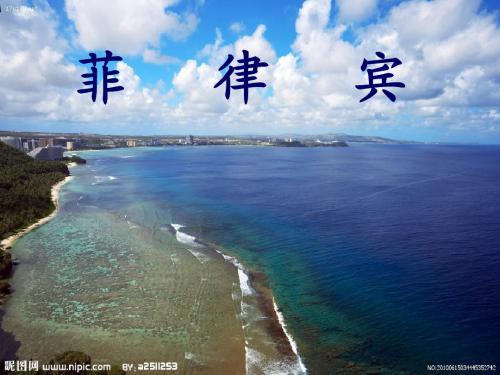
•
•
【国徽 国徽】为盾形。中央是太阳放射 国徽 光芒图案,三颗五角星在盾面上部, 其寓意同国旗。左下方为蓝地黄色 的鹰,右下方为红地黄色狮子。狮 子和鹰图案分别为在西班牙和美国 殖民统治时期菲律宾的标志,象征 菲律宾摆脱殖民统治、获得独立的 历史进程。盾徽下面的白色绶带上 用英文写着“菲律宾共和国”。
• 【自然地理 自然地理】位于亚洲东南部, 自然地理 西濒南中国海,东临太平洋, 是一个群岛国家,共有大小岛 屿7107个。这些岛屿像一 颗颗闪烁的明珠,星罗棋布地 镶嵌在西太平洋的万顷碧波之 中,菲律宾也因此拥有“西太 平洋明珠”的美誉。菲律宾陆 地面积29.97万平方公里, 其中吕宋岛、棉兰老岛、萨马 岛等11个主要岛屿占全国面 积的96%。菲律宾海岸线长 达18533公里,多天然良 港。菲律宾属季风型热带雨林 气候,高温多雨,植物资源十 分丰富,热带植物多达万种, 素有“花园岛国”的美称。其 森林面积为1585万公顷, 覆盖率达53%,产有乌木、 檀木等名贵木材 。
• 国力 • 产经结构以农业及工业为主,尤其着重于食品加工、纺织成衣以及电子、汽 车组件等轻工业。大部分的工业集中于马尼拉大都会的市郊。此外,宿雾大 都会近来也成为吸引外国及本地投资的另一个地点。菲律宾的矿业有很大的 潜力,拥有大量储备的铬铁矿、镍及铜。近来在帕拉湾外岛发现的天然气, 也是菲律宾丰富的地热、水力及煤炭等能源储备的一部分。 • 菲律宾所得大约为1455美元(2007年),为发展中国家,但贫富差距很大; 首都马尼拉为国际第24大购买力城市。 • 出口导向型经济。第三产业在国民经济中地位突出,同时农业和制造业 也占相当比重。
• 【国歌】《菲律宾民族进行曲》 国歌】 • 【国树】纳拉树,是紫檀木的一种 国树】 国树 • 【国花】称为“桑巴吉塔”的茉莉 国花】 花 • 【国石 国石】珍珠 国石 • 【国果】芒果 国果】 • 【国鸟 国鸟】菲律宾鹰 国鸟 • 【重要节日 重要节日】独立日:6月12日 重要节日 (1898年);国庆日:6月1 2日(1898年);自由日:2 月25日;巴丹日:4月9日(纪 念二战阵亡战士);五月花节:5 月最后一个星期日;国家英雄日: 8月27日;英雄节(纪念民族英 雄黎刹就义):12月30日。
菲律宾资料
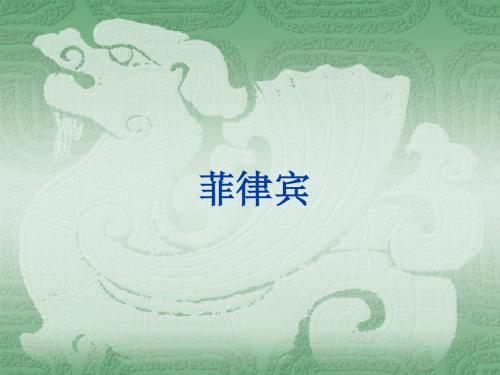
(二)奴隶制社会时期的菲律宾
5、合猫里,在今吕宋岛南部,何乔远《名山藏》
中记载:“地小土瘠,而知耕稼”。 6、麻剌(古麻剌朗),在今棉兰老,永乐十八年 (1420),国王曾来中国朝贡。 15世纪,阿拉伯商人把伊斯兰教传入菲律宾南部的棉 兰老岛。1515年,阿拉伯人谢里夫· 卡本斯旺从柔佛 带了一批人到棉兰老岛传播伊斯兰教,在棉兰老岛建 立了马巾达瑙苏丹国,成为当地第一个苏丹。这些阿 拉伯人被后来的西班牙人称为“摩洛”,意为信伊斯 兰教的摩尔人。 16世纪,伊斯兰教在菲律宾得到突飞猛进的发展,该 地区曾建立起三个伊斯兰政府。
菲律宾
教学内容
一、菲律宾概况
二、菲律宾简史 三、菲律宾的文化
四、菲律宾主要旅游景区景点
一、菲律宾概况
(一)国名、国旗、国徽、国歌
(二)自然地理概况 (三)人口、民族和语言
(四)行政区划
(五)菲律宾的经济
(六)菲律宾货币
(一)国名
菲律宾共和国。 在我国古代史籍中,菲律宾群岛曾被称为吕宋、麻逸、
(五)菲律宾的经济
1、自然资源:菲律宾的自然资源十分丰富。 矿产资源:至今全岛仍有1/4的土地未被勘测。其 主要矿产资源有铜、金、银、铁、铬、镍、煤、天 然气等20余种。其中,铜是该国的最主要矿产,已 探明的铜储量约为41.06亿吨,镍矿储量为15.86亿 吨,金矿储量为1.07亿吨。 菲律宾森林面积为1250万公顷,覆盖率约40%, 出产红木、樟木等名贵木材。 水产资源丰富,鱼类品种达2400多种,主要有鲳 鱼、鲭鱼和乌贼等,金枪鱼资源居世界前列。苏禄 岛沿岸是著名的珍珠和海龟产地。现已开发的海水、 淡水渔场面积2080平方公里。
(三)殖民统治时期的菲律宾
菲律宾
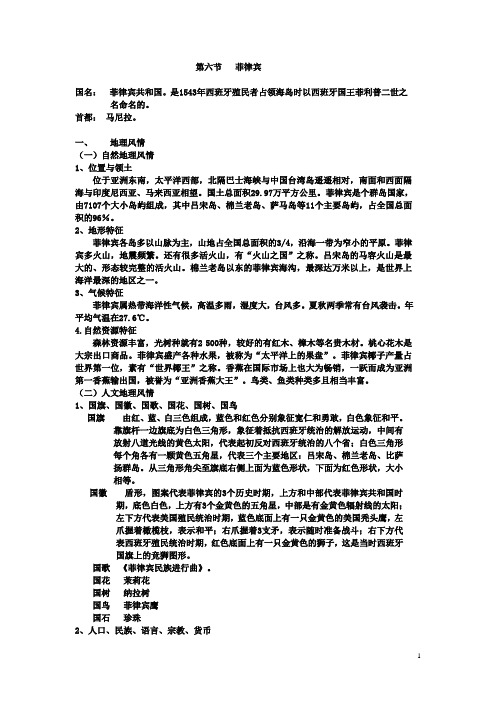
第六节菲律宾国名:菲律宾共和国。
是1543年西班牙殖民者占领海岛时以西班牙国王菲利普二世之名命名的。
首都:马尼拉。
一、地理风情(一)自然地理风情1、位置与领土位于亚洲东南,太平洋西部,北隔巴士海峡与中国台湾岛遥遥相对,南面和西面隔海与印度尼西亚、马来西亚相望。
国土总面积29.97万平方公里。
菲律宾是个群岛国家,由7107个大小岛屿组成,其中吕宋岛、棉兰老岛、萨马岛等11个主要岛屿,占全国总面积的96%。
2、地形特征菲律宾各岛多以山脉为主,山地占全国总面积的3/4,沿海一带为窄小的平原。
菲律宾多火山,地震频繁。
还有很多活火山,有“火山之国”之称。
吕宋岛的马容火山是最大的、形态较完整的活火山。
棉兰老岛以东的菲律宾海沟,最深达万米以上,是世界上海洋最深的地区之一。
3、气候特征菲律宾属热带海洋性气候,高温多雨,湿度大,台风多。
夏秋两季常有台风袭击。
年平均气温在27.6℃。
4.自然资源特征森林资源丰富,光树种就有2 500种,较好的有红木、樟木等名贵木材。
桃心花木是大宗出口商品。
菲律宾盛产各种水果,被称为“太平洋上的果盘”。
菲律宾椰子产量占世界第一位,素有“世界椰王”之称。
香蕉在国际市场上也大为畅销,一跃而成为亚洲第一香蕉输出国,被誉为“亚洲香蕉大王”。
鸟类、鱼类种类多且相当丰富。
(二)人文地理风情1、国旗、国徽、国歌、国花、国树、国鸟国旗由红、蓝、白三色组成,蓝色和红色分别象征宽仁和勇敢,白色象征和平。
靠旗杆一边旗底为白色三角形,象征着抵抗西班牙统治的解放运动,中间有放射八道光线的黄色太阳,代表起初反对西班牙统治的八个省;白色三角形每个角各有一颗黄色五角星,代表三个主要地区:吕宋岛、棉兰老岛、比萨扬群岛。
从三角形角尖至旗底右侧上面为蓝色形状,下面为红色形状,大小相等。
国徽盾形,图案代表菲律宾的3个历史时期,上方和中部代表菲律宾共和国时期,底色白色,上方有3个金黄色的五角星,中部是有金黄色辐射线的太阳;左下方代表美国殖民统治时期,蓝色底面上有一只金黄色的美国秃头鹰,左爪握着橄榄枝,表示和平;右爪握着3支矛,表示随时准备战斗;右下方代表西班牙殖民统治时期,红色底面上有一只金黄色的狮子,这是当时西班牙国旗上的竞狮图形。
客源国概况 菲律宾

礼尚往来是菲律宾人的一大特点。菲律宾
人喜欢送礼,也喜欢收取礼物。
民俗风情——主要禁忌
在与菲律宾人交往时,要尽量回避“13”这个数字,菲律宾对 星期五也存在忌讳,如果某月13日又逢星期五,则被认为大不吉 利。 在招呼别人时,要伸直手臀,手掌向下,摆动指头。而手掌 向上,被认为是一种侮辱。而且,也不要把手掌放在臀部或长时 间用眼光直视别人,这往往是挑衅的象征。 避免谈论菲律宾内政、天主教会及政治人物。
民俗风情——习俗
菲律宾很多生活习惯与西方国家相似,并 带有浓厚的宗教色彩。如果当地人邀请您到家 里访问,或邀请您去郊游您都不可拒绝,因为 那样,对方会认为您是在轻视自己。 菲律宾人喜欢外国人赞扬他们的国家、他 们的家庭,适当得体的称颂会使双方成为朋友。 相反,当众羞辱或令其难堪,往往会激起磨擦, 甚至拳头相向。日常话题应以婚姻、家庭、职 业、烹饪等为主。
【国徽】为盾形。 中央是太阳放射光 芒图案,三颗五角 星在盾面上部,其 寓意同国旗。左下 方为蓝地黄色的鹰, 右下方为红地黄色 狮子。狮子和鹰图 案分别为在西班牙 和美国殖民统治时 期菲律宾的标志, 象征菲律宾摆脱殖 民统治、获得独立 的历史进程。盾徽 下面的白色绶带上 用英文写着“菲律 宾共和国”。
【国花】茉莉花菲律宾国花是被称为“桑巴吉塔”的茉莉花。
这是一种灌木类植物,一般高一米多,花色洁白、香味 浓郁,有单瓣和双瓣两种。据说,古代菲律宾男子向她 心爱的姑娘求婚时,一般都赠送茉莉花花环。如果姑娘 将花环挂在脖子上,就意味着接受了他的爱。然后,他 们在月光下用他加禄语誓约:“桑巴吉塔”(我答应永远 爱你)。因此,茉莉花在菲律宾又称之为“誓爱花”。
3、国旗与首都
呈横长方形,长与宽之比为2∶1。靠旗杆一侧为白色等边三角形,中间是放射 着八束光芒的黄色太阳,三颗黄色的五角星分别在三角形的三个角上。旗面右边 是红蓝两色的直角梯形,两色的上下位置可以调换。平时蓝色在上,战时红色在 上。太阳和光芒图案象征自由;八道较长的光束代表最初起义争取民族解放和独 立的八个省,其余光芒表示其他省。三颗五角星代表菲直、红色象征勇气,白色象征和平和纯洁。
菲律宾简介

9.人口语言
• 人口1亿(2014年7月)。马来族占全国人口 的85%以上,包括他加禄人、伊洛戈人、邦 班牙人、维萨亚人和比科尔人等;少数民族 及外来后裔有华人、阿拉伯人、印度人、西 班牙人和美国人;还有为数不多的原住民。 有70多种语言。国语是以他加禄语为基础的 菲律宾语,英语为官方语言。国民约85%信 奉天主教,4.9%信奉伊斯兰教,少数人信奉 独立教和基督教新教,华人多信奉佛教,原 住民多信奉原始宗教。首都大马尼拉市 (MetroManila),人口1186万(2010年5 月)。 人口总数 (2012年)96,707,000人均国 民总收入(PPP国际美元, 2012年)4,380男/ 女出生期望寿命(岁, 2012年)65/725岁以 下儿童死亡率(每1000活产儿, 0年)无数据 15岁至60岁男/女死亡率(每1000人, 2012 年)258/138人均卫生总支出(PPP国际美元, 2012年)202卫生总支出占国内生产总值的 百分比(2012年)通常菲律宾人说英语或
2.菲律宾国旗简介
Байду номын сангаас
长方形,长宽之比为2:1。 旗面左侧为白色等边三角形, 内有一黄色太阳,各角有一颗 黄色五角星。右侧为蓝,红两 色的直角梯形,平时蓝色在上, 战时红色在上。太阳象征自由, 八道较长的光束代表最初起义 的八个省,其余光束代表其它 省。三颗五角星代表三大地区: 吕宋,萨马,棉兰老。蓝色象 征忠心,诚实,正直。红色象 征勇气。白色象征和平与纯洁。
菲律宾简介
刘时刚
1.菲律宾地图简介
• 菲律宾共和国(他加禄语: Republika ng Pilipinas)位于 亚洲东部,由太平洋的菲律宾 群岛(7107个岛屿)及其周边 大小岛屿组成。北隔巴士海峡 与中国台湾省遥遥相对。南和 西南隔苏拉威西海、巴拉巴克 海峡与印度尼西亚、马来西亚 相望。西濒南中国海,东临太 平洋。共有大小岛屿7107个, 其中2,400个岛有名称,1, 000多个岛有居民。吕宋岛、棉 兰老岛、萨马岛等11个主要岛 屿占全国总面积的96%。【面 积】 29.97万平方公里(根据菲 内务与地方政府部资料)。
- 1、下载文档前请自行甄别文档内容的完整性,平台不提供额外的编辑、内容补充、找答案等附加服务。
- 2、"仅部分预览"的文档,不可在线预览部分如存在完整性等问题,可反馈申请退款(可完整预览的文档不适用该条件!)。
- 3、如文档侵犯您的权益,请联系客服反馈,我们会尽快为您处理(人工客服工作时间:9:00-18:30)。
Anthem:The Anthem was composed by Julian Felipe, a Filipino music teacher and composer in 1898.At the end of 1899, a young poet-soldier named Jose Palma wrote a poem entitled Filipinas, which then became the words of the anthem .
local long form: Republika ng Pilipinas local short form: Pilipinas
Republic of the Philippines
Geography
Location: Southeastern Asia, between the Philippine Sea and the South China Sea, east of Vietnam
Republic of the Philippines
Currency
The currency in the Phthe Peso (P). Philippine Peso (Piso) made up one hundred centavos (sentimos). Peso (PHP) (Piso)= 100 Centavos (Sentimos) Notes are in denominations of P1000, 500, 200, 100, 50, 20, 10 and 5. Coins are in denominations of P10, 5, 2 and 1, and 25, 10, 5 and 1 centavos.
Republic of the Philippines the Flag
Symbolic Meaning:
The Sun: represents the dawning of a new era of selfdetermination desired in 1897 after the Spanish-American war and the US promise of independence, which was granted in 1946. The 8 rays: stand for the 8 provinces that rose in revolt against Spanish rule in the late 19th century. The 3 Stars: represents the 3 principal geographic areas of the country---Luzon, Visayas, and Mindanao. The red area of the flag: represents courage and bravery. The blue area of the flag: represents noble ideas.
Area:
total: 300,000sqkm
(about 2 times as big as Liaoning Province) land: 298,170sqkm water: 1,830 sq km
Map: 1, 2 Capital: Manila
Republic of the Philippines
Republic of the Philippines
the Flag
Description of the flag:
two equal horizontal bands of blue (top) and red with a white equilateral triangle based on the hoist side; in the center of the triangle is a yellow sun with eight primary rays (each containing three individual rays) and in each corner of the triangle is a small yellow five-pointed star
Roman Catholic Protestant Muslim Buddist and others
Christian Malay Muslim Malay Chinese others
Republic of the Philippines
the People Regional groups:
the north the sturdy and frugal Ilocanos the industrious Tagalog the central plains the carefree Visayans the central islands the colorful tribes-men and religious Moslems
North: Luzon Strait West: South China Sea Southwest: Sulu Sea South: Celebes Sea East: Philippine Sea
three main groups of islands :
The Philippine archipelago is made up of 7,107 islands.
Republic of the Philippines
the Emblem
Description of the emblem: The National Coat-of-Arms have: Paleways of two pieces, azure and gules; a chief argent studded with three mullets equidistant from each other; and, in point of honor, ovoid argent over all the sun rayonnant with eight minor and lesser rays. Beneath is the scroll with the words "REPUBLIKA NG PILIPINAS".
Luzon (the largest island in the Philippine archipelago and home to almost half of the country's population) Visayas Mindanao (the second largest island in the Philippines comprising 34% of the national territory)
Republic of the Philippines
National Symbols and Anthem
Symbol: The Philippines have several national symbols, for example, the Carabao (water buffalo), the Narra-Tree(Pterocarpus indicus /Red Sandalwood tree ) and a species of jasmines called Sampaguita or kampupot in Tagalog.
Geography
Surrounding countries:
Northwest: The Republic of China
West:
Vietnam, Malaysia
South :
Indonesia
Republic of the Philippines
Geography
Surrounding waters:
Republic of the Philippines
Currency
Republic of the Philippines currency
Republic of the Philippines currency
Republic of the Philippines currency
10 Peso in coin
5 Peso in coin
2 Peso in coin (no longer minted)
1 Peso in coin
25 Centavos
10 Centavos
5 Centavos
1 Centavos
Republic of the Philippines
the People
The Filipino is basically of Malay stock with a sprinkling of Chinese, American, Spanish and Arab blood. However, it is hard to distinguish accurately the lines between stocks. From a long history of Western colonial rule, interspersed with the visits of merchants and traders, evolved a people of a unique blend of east and west, both in appearance and culture. Population: 87,857,473 (2005 estimate) Largest cities with population : Quezon City, 2,160,000 (2000) Manila, 1,673,000 (2000) Caloocan, 1,157,881 (1999 estimate)
